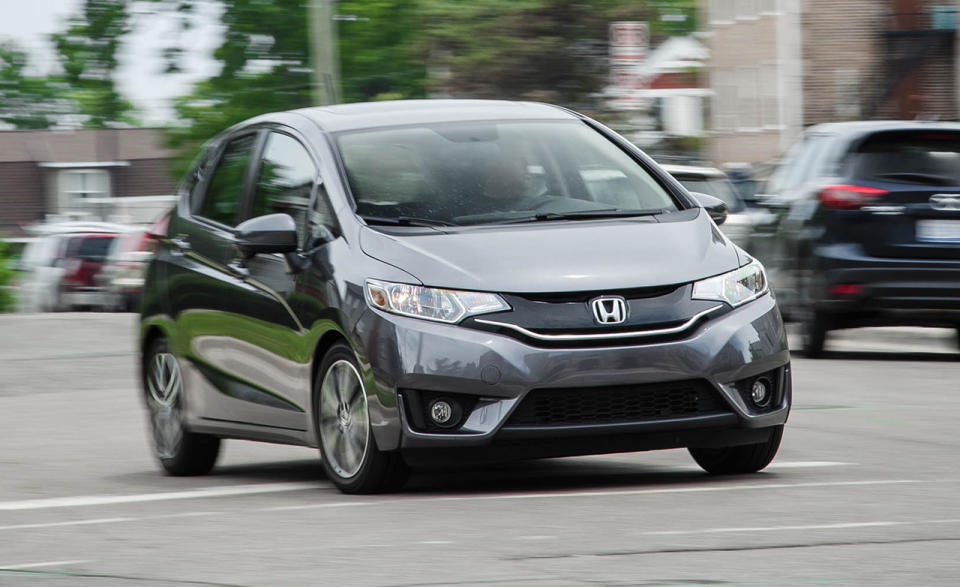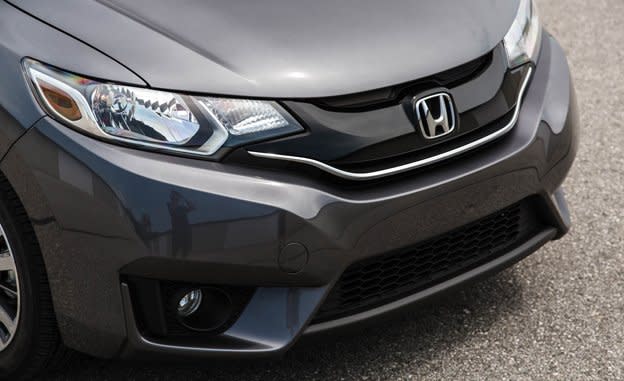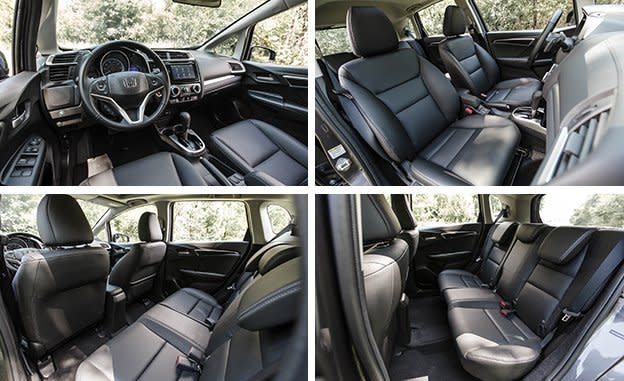2016 Honda Fit Automatic

The Honda Fit answers multiple automotive questions. Need cheap, dependable transportation? It has a base price below $17,000 and carries Honda’s strong reputation for reliability. Need a high-mpg commuter? The Fit is EPA-rated at up to 41 mpg on the highway. Need lots of space? For a vehicle of its size, the Fit offers an unbelievable amount of interior room; according to the EPA, it provides the passenger volume and cargo space of a mid-size car.
In its previous two generations, the Fit also gave convincing answers for the sorts of questions we ask of cars. It wasn’t quick by sports-car standards, but it boasted an eager engine and sharp responses from a well-sorted chassis. We named the Fit to our list of 10Best Cars for seven straight years, from 2007 to 2013, and found ourselves recommending it often to friends and family.

The third-generation Fit, introduced for 2015, has traded some of its edginess and verve in search of greater refinement and maturity. It’s fallen off our 10Best list in recent years, largely because it doesn’t raise our pulse quite the way its predecessors did. It still has the same unbeatable combination of practicality, affordability, and efficiency; the little Honda remains one of our top recommendations when we’re asked which small car to buy.
Ingenious Interior
The genius of the Fit starts with Honda’s innovative chassis layout that places the fuel tank under the front seats, rather than the more conventional location farther rearward. This yields an extremely low and flat floor under the rear seats and in the cargo area, allowing for interior space rivaling that of some larger crossovers, despite the Fit’s diminutive footprint. The rear seat will accommodate even the tallest passengers with ease, and the entire cabin feels light and airy thanks to large windows all around. This is also a boon for visibility.
But the real magic happens when you start messing with the highly configurable, split-folding rear seats, which Honda aptly dubs “Magic Seats.” You can either flip up the bottom cushions to create a tall, narrow space or fold the seat flat to the floor. Doing the latter opens up 53 cubic feet of cargo space that’s almost completely unobstructed by wheel wells or other intrusions. Bicycles, bookshelves, boxes—almost everything fits in the Fit.
The rear seats are lightweight enough to make all this flipping and folding mostly effortless, but they also are sufficiently padded to make the back row a relatively comfortable place to sit. It’s all rather marvelous and is still impressive nearly a decade after we first came in contact with this space-efficient interior design.
Tech Story
Less magical is Honda’s insistence on touch-sensitive controls for its audio and navigation. We understand the desire to appear tech-savvy, but the Fit’s setup, shared with many other Hondas, is more frustrating than forward thinking. In the upper trim levels, a 7.0-inch touchscreen dominates the Fit’s dashboard, flanked by a flat, featureless panel with capacitive-touch buttons. Combine these fussy controls with a confusing menu layout and slow responses, and tasks as simple as tuning the radio or adjusting the volume become onerous and distracting.

The 7.0-inch screen comes standard on three of the Fit’s four trim levels, including the EX, the EX-L, and the EX-L with Navigation that we tested. Certain features such as Pandora integration, Honda’s LaneWatch side-camera system, and text-message integration are offered only on this larger touchscreen, but the Fit is still missing the Apple CarPlay and Android Auto smartphone capabilities found in Honda’s own Civic and Accord (as well as many of the Fit’s competitors). The Fit also cannot be optioned with any of the active-safety features such as blind-spot warning and forward-collision warning that are becoming de rigueur across all vehicle classes.
A mid-cycle refresh for the Fit, likely to arrive within the next year, should remedy these omissions. For now, the base-model Fit LX, starting at $16,725, strikes us as the smart buy of the lineup. You’ll give up features such as 16-inch wheels, a sunroof, and push-button start, but the LX model’s smaller touchscreen, with more conventional knobs and buttons, is much simpler and easier to use than the larger version. Plus, the LX isn’t a total stripper; it comes standard with a backup camera, Bluetooth audio streaming, and a USB port.
Questionable Transmission
Regardless of trim level, the Fit has one of the strongest engines in its class, a 1.5-liter four-cylinder engine with 130 horsepower and 114 lb-ft of torque. At 8.5 seconds from zero to 60 mph, this CVT-equipped Fit beats all its automatic subcompact competitors, including the Ford Fiesta (8.7 seconds), Nissan Versa Note (9.9 seconds), Scion iA (9.1 seconds), and Toyota Yaris (10.2 seconds). That relative quickness doesn’t come at the expense of fuel economy, either, as the Fit, at our observed 33 mpg, was more efficient in our hands than all of those rivals save for the miserly Scion (actually a rebadged Mazda 2), which achieved 36 mpg.
For all its objective excellence, the Fit’s powertrain is disappointing on the road. The continuously variable automatic, seemingly tuned for fuel economy above all else, is overly insistent on keeping engine revs low. That limits access to the 1.5-liter’s power peak, which doesn’t come on until 6600 rpm, making the Fit feel sluggish around town. Push the accelerator more emphatically to merge or to pass slower traffic, and the CVT begrudgingly gives in, allowing the engine to spool up to the higher reaches of the rev range for more muscle. But then the little four-cylinder drones noisily and reveals its buzzy, unrefined character. At least the CVT enables quieter freeway cruising once you’re up to speed; its gearing is taller than that of the Fit’s six-speed manual transmission (standard on LX and EX models), which spins the engine at 4000 rpm at 80 mph, making road trips somewhat taxing.

Some drivers might not mind trading the manual Fit’s increased fun factor and improved performance (it’s 0.5 second quicker to 60 mph than the CVT model) for the automatic’s more relaxed demeanor. But we’d certainly choose the stick—especially given the $800 premium for the automatic. Like we said before, it’s best to keep the Fit closer to its cheap, cheerful roots, in contrast to our $22,000, automatic-equipped, leather-lined test car.
Not as Sharp as It Used to Be
The Fit’s handling was once in a class of its own, but that’s no longer the case. Many other subcompacts—including Chevrolet’s Sonic, Ford’s Fiesta, and Scion’s iA—have more playful chassis dynamics and offer more grip on the skidpad than the Fit’s 0.80 g. The Honda’s 184-foot braking distance from 70 mph is also midpack for its competitive set.
Despite this, the Fit continues to be a pleasant small car to drive. Its ride quality is satisfyingly firm but avoids the impact harshness of the previous-generation Fit, and its light steering combines with great visibility to make it eminently maneuverable around town. Many buyers will be happy to compromise sportiness for these sorts of attributes, but we can’t help but miss the sharper responses and more eager demeanor of the Fit’s predecessor.
Our love affair with the Honda Fit may have cooled a bit. But we still like this well-rounded hatchback; it remains one of the smartest buys in the automotive marketplace. Our only unanswered question is: When can we get a high-performance Fit Si?
Specifications >
VEHICLE TYPE: front-engine, front-wheel-drive, 5-passenger, 4-door hatchback
PRICE AS TESTED: $22,000 (base price: $17,525)
ENGINE TYPE: DOHC 16-valve inline-4, aluminum block and head, direct fuel injection
Displacement: 91 cu in, 1498 cc
Power: 130 hp @ 6600 rpm
Torque: 114 lb-ft @ 4600 rpm
TRANSMISSION: continuously variable automatic with manual shifting mode
DIMENSIONS:
Wheelbase: 99.6 in
Length: 160.0 in
Width: 67.0 in Height: 60.0 in
Passenger volume: 94 cu ft
Cargo volume: 17 cu ft
Curb weight: 2634 lb
C/D TEST RESULTS:
Zero to 60 mph: 8.5 sec
Zero to 100 mph: 26.4 sec
Zero to 110 mph: 37.1 sec
Rolling start, 5–60 mph: 8.7 sec
Top gear, 30–50 mph: 4.6 sec
Top gear, 50–70 mph: 6.1 sec
Standing ¼-mile: 16.8 sec @ 84 mph
Top speed (governor limited): 119 mph
Braking, 70–0 mph: 184 ft
Roadholding, 300-ft-dia skidpad: 0.80 g
FUEL ECONOMY:
EPA city/highway driving: 32/38 mpg
C/D observed: 33 mpg

 Yahoo Autos
Yahoo Autos 